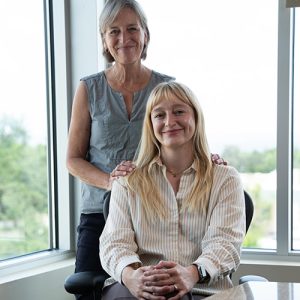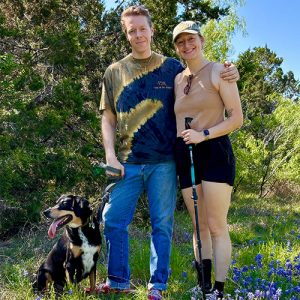
Lillian’s life in Austin was full of music, movement, and momentum. A Houston native, she moved to the capital to attend the University of Texas and quickly fell in love with the city’s vibrant culture. Lillian landed her dream job at Austin PBS and had just bought a home with her husband when on February 5, 2025, a stroke interrupted her momentum and set her on a new path of recovery.
Lillian had been experiencing mild neck pain for a couple of weeks but assumed it was due to stress or sleeping wrong. “Stroke wasn’t even on my radar,” she said. Working from home, she felt a sudden wave of exhaustion and she collapsed. Her husband rushed her to the hospital, where she was admitted to the ICU. Doctors told her she had experienced a stroke.
“I lost sensation on the right side of my body and couldn’t speak clearly,” she recalled. “It was terrifying not being able to express my thoughts.”
After receiving emergency treatment and spending time in two hospitals, Lillian was transferred to St. David’s Rehabilitation Hospital’s Young Stroke Survivors Program. Lillian began the long road to recovery. At first, she was wheelchair-bound and needed assistance for even the smallest movements.
“I was almost in denial,” she said. “I thought I’d bounce back in a week. But I had to accept that this was going to be a journey.”
That journey brought her to Centre for Neuro Skills (CNS) Austin in March 2025. At CNS, Lillian found not only expert therapists, but also a community that believed in her goals. “When I started, I was using a trekking pole just to get around. I set a goal of 6,000 steps a day. Now I’m doing 10,000 without any assistance.”
Lillian’s therapy was tailored to her passions. To help her return to hiking, her physical therapy team simulated trail-like conditions using foam and blocks under gym mats. To prepare her for walking her 75-pound dog, they used resistance bands as Lillian used the Zero-G Gait and Balance System on the treadmill.
“The creativity of the CNS team blew me away,” she said. “They really listened to what I wanted to get back to.”
Motivated to return to work, Lillian also worked on cognitive rehabilitation. She created a resource guide on ADA accessibility at music venues, something she had never considered before her stroke. “There are entire communities who love music but need a little extra support,” she said. She also produced a “Day in the Life” video, using her background in media to document her progress and overcome visual challenges.
 Throughout her recovery, Lillian’s mother, a marathon runner, has been by her side nearly every step of the way. The two recently completed a 5K walk together, a milestone that symbolized how far Lillian has come. “Running feels attainable again,” she said. “It’s a life-changing feeling to go from rock bottom to believing in your goals again.”
Throughout her recovery, Lillian’s mother, a marathon runner, has been by her side nearly every step of the way. The two recently completed a 5K walk together, a milestone that symbolized how far Lillian has come. “Running feels attainable again,” she said. “It’s a life-changing feeling to go from rock bottom to believing in your goals again.”
Now back at work part-time, Lillian is enjoying concerts, coffee shops, and exploring the city that first inspired her with a new perspective on life.
“I’m not just learning how to survive anymore. I’m learning to live again. CNS helped me believe that was possible.”
CNS Monthly Newsletter
The latest CNS updates, including events, company information, and patient care developments
The Inside View
Quarterly magazine focused on brain injury research, rehabilitation, and advancements shaping the field
Sign-up for one or both to stay connected with brain injury news and recover